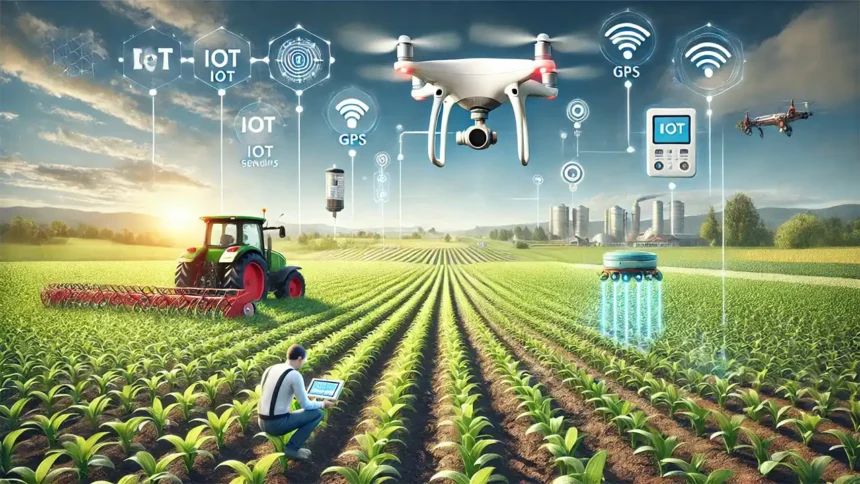Do You Know the Use of Technology in Agriculture, What Technology Do Farmers Use
Agriculture, a vital part of life for centuries, has evolved with technology to meet modern challenges such as climate change, resource scarcity, and rising population demands. Today, farmers use advanced tools that not only improve productivity but also make farming more sustainable. From IoT sensors to AI-based analytics, technological advancements are reshaping agriculture globally. This article explores What Technology Do Farmers Use today to ensure efficient, productive, and sustainable farming.
1. Precision Agriculture
Precision agriculture uses data and technology to help farmers apply precise amounts of water, fertilizer, and pesticides based on specific crop and soil needs. GPS technology and Geographic Information Systems (GIS) play a crucial role here. For example, satellite imagery helps farmers monitor crop health and data analytics software predicts growth patterns, helping them decide the optimal time for planting and harvesting.
Precision agriculture can help conserve water, reduce chemical use, and improve crop yields, making it a popular choice among farmers, especially for large-scale farming.
2. Drones and Aerial Imaging
Drones have become an invaluable tool for farmers, providing aerial views of fields to monitor crop health, soil conditions, and water usage. By capturing high-resolution images, drones can help identify issues such as pest infestations or nutrient deficiencies early on. Advanced drones equipped with multispectral imaging can analyze data and provide insights into the best fertilization practices.
Using drones allows farmers to survey large areas quickly, gather data efficiently, and reduce manual labor, ultimately saving time and money while boosting productivity.
3. Internet of Things (IoT) in Agriculture
IoT technology connects various farming tools and systems, enabling remote monitoring and control. Sensors are placed in the soil to measure moisture levels, monitor temperature, and track crop health, sending real-time data to farmers’ devices. With this information, farmers can manage irrigation systems, adjusting them based on the specific needs of each area of their fields, which minimizes water waste.
IoT in agriculture not only enhances resource management but also promotes smart farming, where farmers can track and automate several aspects of their operations from a central dashboard, improving efficiency and crop yield.
4. Artificial Intelligence and Machine Learning
AI and machine learning are transforming farming by analyzing vast amounts of data to provide valuable insights. AI-based software can analyze weather data, predict pest invasions, and suggest optimal planting times. Machine learning models use historical data to improve the accuracy of these predictions over time, helping farmers make better-informed decisions.
For example, machine vision technology helps sort and grade fruits and vegetables quickly, while AI-powered robotics assist with planting, harvesting, and packaging, reducing labor costs and increasing output.
5. Robotics and Automation
Robotic technology has made farming more efficient by automating repetitive tasks like planting, weeding, and harvesting. Autonomous tractors, for instance, use GPS and sensors to navigate fields, reducing the need for manual labor. Robots designed for fruit picking can handle delicate fruits like strawberries, which reduces crop loss and speeds up the harvesting process.
Farm automation also helps farmers manage labor shortages and ensures that crops are handled delicately, preserving their quality until they reach the consumer.
6. Blockchain for Supply Chain Transparency
Blockchain technology is gaining traction in agriculture for its ability to increase transparency and traceability in the food supply chain. By recording every transaction and movement of products from the farm to the market, blockchain helps build trust among consumers who are increasingly interested in knowing where their food comes from.
For instance, blockchain technology allows customers to trace the origin of a product and ensure that it meets certain quality and safety standards, which is essential for organic or specialty foods. This transparency benefits both consumers and farmers, who can gain better market access for quality products.
7. Big Data and Analytics
Big data in agriculture is transforming the way farmers operate. By analyzing massive datasets collected from weather stations, soil sensors, and market trends, farmers can make informed decisions. Predictive analytics help forecast crop yields, optimize resource use, and reduce waste.
This technology is especially useful for planning purposes, allowing farmers to adjust their practices based on market demand, climate forecasts, and soil conditions, ultimately reducing risks and increasing productivity.
8. Vertical Farming and Hydroponics
Vertical farming, a method where crops are grown in stacked layers, and hydroponics, where plants are grown without soil, are innovative solutions for urban areas with limited farmland. These methods utilize LED lighting, climate control, and nutrient-rich water to grow crops indoors, allowing year-round production without the need for pesticides.
Vertical farming and hydroponics use less water and space, making them environmentally sustainable options that can produce high yields of fresh produce close to urban markets.
9. Biotech and Genetic Engineering
Biotechnology has introduced genetically modified (GM) crops that are resistant to pests, diseases, and extreme weather. Biotech advances also allow crops to mature faster, produce higher yields, and improve nutrient content, helping address food security.
By using genetically modified seeds, farmers can ensure higher crop resilience, fewer chemical inputs, and more consistent production, contributing to the sustainable growth of agriculture.
10. Mobile Apps and Digital Platforms
Mobile applications have become essential for farmers to manage operations, track market prices, and receive weather forecasts. Digital platforms connect farmers with suppliers and buyers, providing access to resources and markets that would otherwise be out of reach.
These apps also provide educational resources, farming tips, and community support, allowing farmers, especially smallholders, to improve their practices and expand their businesses.
Conclusion
Technology is revolutionizing agriculture, helping farmers increase productivity, reduce environmental impact, and meet global food demands. From AI-powered analytics to IoT-connected sensors, each technology plays a role in building a more sustainable and efficient agricultural system. These innovations provide farmers with the tools to adapt to modern challenges and help secure food supplies for future generations.
FAQs
How does technology help in sustainable farming?
Technology like IoT sensors and precision agriculture helps farmers use resources efficiently, reducing waste and minimizing environmental impact.
What is the role of AI in agriculture?
AI provides predictive insights, helping farmers make data-driven decisions about planting, harvesting, and pest management.
Why is blockchain important in agriculture?
Blockchain ensures transparency in the food supply chain, allowing consumers to trace the origin of products and verify quality.
How do drones benefit farmers?
Drones provide aerial views that help farmers monitor crop health, detect issues early, and make informed decisions about field management.





